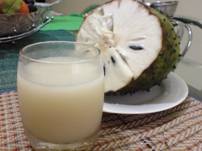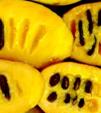1-2-3 Cancer Treatment Plan
 |
Graviola or paw paw protocol"NON-STAGE IV / Add-On treatment |
Do not use with any other alternative treatment!
Graviola / Paw Paw should not be used by anyone who is pregnant, who may be pregnant or who may become pregnant (since fetal cells are fast-growing).
Graviola Protocol (sometimes called the Amazon Factor) was designed by Tracy Gibbs, Phd, - who studied alternative medicine in Japan.
This treatment protocol is primarily for newly diagnosed patients, NOT for those with a fast-growing cancer or significant metasases.
Advanced cancer patients, those who have had a lot of chemotherapy, radiation or surgery or have a potentially fast-growing cancer should choose:

|
BUDWIG / PLASMA PROTOCOL |

|
CESIUM CHLORIDE/DMSO PROTOCOL |

Graviola powdered twigs/leaves or Paw Paw twig extracts target fast-growing cells. Graviola / Paw Paw should not be used by anyone who is pregnant, who may be pregnant or who may become pregnant (since fetal cells are fast-growing).
Simple and mild therapy. Cancer patient would not know they were on a potent alternative cancer treatment.
The twigs of graviola and paw paw contain annonaceous acetogenins with beneficial effects against cancer. Acetogenins are long-chained, fatty acid substances with some very unique properties. Of over 3500 plants screened by a National Cancer Institute (NCI)-funded project at Pudue University led by Dr. Jerry McLaughlin, the actegenin compounds of the Annonaceae family had the most anti-cancer potential. Of these, the paw paw and graviola plant have especially high concentrations of acetogenins. These acetogenins:
1. SLOW DOWN / STOP the production of ATPenergy molecules in cancer cells (which produce their energy anaerobically). Normal cells (which produce energy aerobically) are insignificantly affected. When the ATP production drops to a critical level the cancer cell dies.
2. Prevents the growth of vessels in or near a tumor
3. Depletes the DNA and RNA building blocks necessary for new, abnormal cell division. Effective against human CEM cell lines in leukemia; proven to reduce DNA and RNA production in 3 days.
4 Kills cells that are resistant to chemotherapy. After some time of being bombarded with chemotherapy drugs, cancer cells self-protectingly develop a mechanism to turn on an ATP-fueled pump that pumps the chemotherapy right out of the cancer cells. Paw Paw prevents this from happening.
Graviola and Paw Paw work similarly, but there are some major differences between them:

Graviola (Annona muricata) is a tropical rainforest South American plant. Its fruit is called guanábana. Common names for it are soursop (English name), custard apple, cherimoya,and Brazilian paw paw. The fruit, leaves, stem, bark, roots, and seeds all have a long-standing medicinal use.

Paw Paw species Asimina triloba is found in North America. Cancer treatments use a patented extract of acetogenins from its twigs. There are other species, but only this species was found to have the cancer-fighting acetigenins. Of these, threehave been identified as the most bioactively potent - bullatacin, asimicin, and trilobacin. To correct a common misconception, paw paw is totally unrelated to papaya.
50 acetogenins found in paw paw, about 30 in graviola
Paw Paw extract is 24-50 times more potent than graviola powder - determined by tests comparing two graviola products with paw paw extracts carried out under supervision of Dr. McLaughlin. Upjohn Company (now Pfizer) found paw paw to be 300 times more potent than Taxol (a leading chemotherapy drug)
Graviola's annonaceous acetogenin content varies drastically if the product is advertised as "freshly ground powder" of twigs and leaves - however, if they are not harvested during the month of May, they are essentially worthless.Also, the acetogenin potency varies drastically even from tree to tree! Generally, graviola manufacturers do not standardize their product. BTW, you could make this yourself if you have access to the graviola plant.
A standardized extract from Paw Paw twigs is so much more potent than graviola, making it the better choice - Dr. McLaughlin, who is now retired, licensed his patents to Nature's Sunshine Products, who sells the product to the public under the name "Paw Paw Cell Reg"
See www.pawpawresearch.com for more information
Paw Paw (or Graviola) Protocol includes other ingredients to keep lymph system clear, protect organs, remove protein coating of cancer cells with enzymes, etc.
| Product | Stock # | How many and when? |
|---|---|---|
| Paw Paw | 515 | 2 capsule 3 times daily WITH food |
| Nature's Noni |
4042-7 |
2-4 oz. Daily |
| Immune Stimulator | 1839-3 | 2 capsules twice daily |
| Protease, High Potency |
1876-1 | 2-4 twice daily on an empty stomach. Upon arising and before retiring |
| Milk Thistle? |
Products are available at *www.NaturesSunshine.com
Continue to use the program a month after the cancer tumor markers are all down and there is no further evidence of the cancer. Finally, use the program at least once a month for two to three years.
Graviola / Paw Paw is synergistic with chemotherapy -holding the chemotoxic drug in the cancer cell longer, allowing it to have more time to do its work. Graviola has been shown effective against drug resistant cancer cells.
Alkaloids(with possible link to Parkinson's Disease) are carefully excluded from the annonaceous extracts during processing of paw paw
Ongoing studies confirm the benefits of paw paw extracts in clinical cancer treatments -Paw paw extracts can be used to inhibit the growth of cancer cells and as effective alternative or supplement to chemotherapeutic agents. A Malaysial clinical study showed exceptional results in terminal, metastasized breast cancer patients(i.e. with additional cancers).
Research studies show that paw paw extracts have anthelmintic (worm controlling) benefits
What applies to graviola also applies to paw paw and vice versa
|
Graviola/Paw Paw can NOT be used concurrently with a treatment or nutrient which RAISES cellular ATP production: Electromedicine (e.g. RIFE RESONANCE PROTOCOL, Beck Protocol), MSM, DMSO, Vitamin C, Hydrogen Peroxide, maple syrup or honey, CoQ10 and some others will nullify the graviola or paw paw Protocol and vice versa. Protocols which kill microbes INSIDE cancer cells allow these cells to produce more ATP energy. For safety and simplicity - Do not use the Graviola or Paw Paw with any other alternative treatment! |
Graviola has demonstrated hypotensive, vasodilator, and cardiodepressant activities in animal studies -graviola (or paw paw)could have adverse consequences for people with low blood pressure or taking antihypertensive drugs.
Should not be taken with any alternative, oxidative (oxidant) cancer treatment - which would neutralize the effect of its acetogenins by raising ATP cellular energy production.
Do not take with CoQ10 -since CoQ10 increases ATP production, it would interfere with graviola's mechanism of action of lowering ATP production.
Do not take with thyroid stimulators -E.g. Iodine,which increase energy production
The paw paw extract manufacturer states that combining paw paw with antioxidants is not an issue with paw paw -"The head of NSP research, Dr. Bill Keller, provided Paw Paw with supporting products to a research oncologist and his laboratory to test with actual cultures. Several of Nature's Sunshine strong antioxidants were also provided. The research personnel concluded overwhelmingly that there was no negative prevention of Paw Paw action as a result of the antioxidants." (Email to CancerTutor.com). Also, see their videos at:
NOTE HOWEVER, that HIGH doses of Vitamin C do not have an antioxidant effect, they are oxidant. As such, they should NOT be combined with Graviola or Paw Paw
For simplicity - Do not use Graviola with any other alternative treatment, with the exception of antioxidants at physiological levels
Do not take Graviola or Paw Paw long-term if no cancer present. If cancer, parasites, or other high energy users are not available, Graviola or Paw Paw may work on fast growing cells lining the GI tract walls. The main manufacturer of Paw Paw Cell Reg, Nature's Sunshine, strongly cautions against its long term use for non-cancer patients. Even some people with cancer have reported digestive distress includingnausea, which is why the recommendation that Graviola/Paw Paw should be taken with food.
|
Technical Mode of Action of Annonaceous acetogenins |
|
Annonaceous acetogenins are only found in the Annonaceae family (to which Graviola and paw paw belong). Studies in three separate laboratories have determined that these acetogenins are superb inhibitors of enzyme processes that are only found in the membranes of cancerous tumor cells. Purdue University, West Lafayette, Indiana (much funded by The National Cancer Institute and/or the National Institute of Health) has conducted a great deal of the research on acetogenins. Purdue University and/or its staff have filed at least nine U.S. and international patents on their work around the anti-tumorous and insecticidal properties and uses of these acetogenins. In a review entitled "Recent Advances in Annonaceous Acetogenins", they state: "Recently, we reported that the Annonaceous acetogenins can selectively inhibit the growth of cancerous cells and also inhibit the growth of adriamycin resistant tumor cells. As more acetogenins have been isolated and additional cytotoxicity assays have been conducted, we have noticed that, although most of acetogenins have high potencies among several solid human tumor cell lines, some of the derivatives within the different structural types and some positional isomers showed remarkable selectivities among certain cell lines; e.g., against prostate cancer (PC-3). We now understand the primary modes of action for the acetogenins. They are potent inhibitors of NADH: ubiquinone oxidoreductase, which is in an essential enzyme in complex I leading to oxidative phosphorylation in mitochondria. A recent report showed that they act directly at the ubiquinone-catalytic site(s) within complex I and in microbial glucose dehydrogenase. They also inhibit the ubiquinone-linked NADH oxidase that is peculiar to the plasma membranes of cancerous cells." |